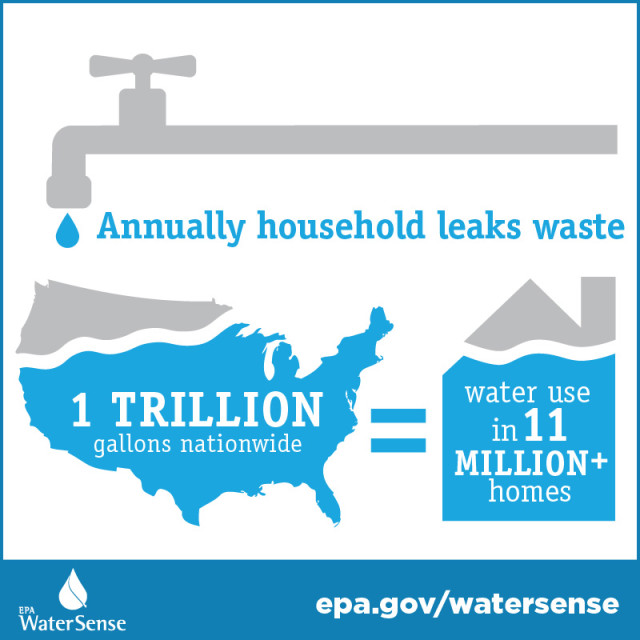 Because it is the EPA & Water Sense’s #FixALeak week, we re-aired a great Green Divas What You Can Do segment on fixing leaks and how much water you can save paying attention to this common household issue. Listen to that segment right here, then read this year’s EPA’s WaterSense guest post packed with helpful water-saving information! ~ GD Editor
Because it is the EPA & Water Sense’s #FixALeak week, we re-aired a great Green Divas What You Can Do segment on fixing leaks and how much water you can save paying attention to this common household issue. Listen to that segment right here, then read this year’s EPA’s WaterSense guest post packed with helpful water-saving information! ~ GD Editor
Becoming a Leak Detective
~ by Beth Livingston, U.S. Environmental Protection Agency’s WaterSense
Have you ever woken up from a nightmare about water leaks around your home only to find out it is real? Imagine you are dreaming of a beautiful beach vacation and the lulling ocean sounds get louder and louder and then turn to drips. You wake up and are staring out in the dark and you hear it—the drip, drip, drip of a faucet and then the toilet flushes and no one is up.
As you lay curled up under your covers until the morning light, you think: What can I do to stop these leaks? I am contributing to the more than 1 trillion gallons of water wasted each year in U.S. homes? In fact, the average household leaks more than 10,000 gallons of water per year, or the amount of water it takes to wash 270 loads of laundry. This could be costing me an extra 10 percent on my water bill. Then you remember that it is Fix a Leak Week—the time of year during March when the EPA’s WaterSense program encourages consumers to “be a leak detective” by finding and fixing leaks around the home.
After you don your “cool” Sherlock Holmes detective hat, grab your proverbial magnifying glass and gather your tools—a wrench, pipe tape, food coloring and the WaterSense Detect and Find Leaks Checklist. The first thing you do is consult the checklist on how to investigate your house to determine if you really have a leak.
Clue #1
Check the Water Bill. A great place to start is to  examine your utility bill for January or February. It’s likely that a family of four has a serious leak problem if its winter water use exceeds 12,000 gallons (or 16 ccf) per month. You can also look for spikes—is your water use a lot higher this month than it was last month?
examine your utility bill for January or February. It’s likely that a family of four has a serious leak problem if its winter water use exceeds 12,000 gallons (or 16 ccf) per month. You can also look for spikes—is your water use a lot higher this month than it was last month?
Clue #2
Read the Water Meter. Find your water meter, which is usually near the curb in front of your home but can be inside your home (e.g., in the basement) in cold climates. Use a screwdriver to remove the lid on your meter, which is heavy and usually marked “water.” Now that you’ve found the meter, take a reading during a period when no water is being used. If the meter does not read exactly the same after two hours, you probably have a leak.
Clue #3
Take the Toilet Test. Put a few drops of food coloring into the tank at the back of your toilet and let it sit for 10 minutes. If color shows up in the bowl, you have a leak. Make sure to flush afterward to avoid staining, and consider replacing your old toilet flapper if it is torn or worn.
While waiting for the toilet test to finish, you might consult the checklist and realize there are other areas of your house where leaks can hide. In the bathroom, tighten the connections to the showerhead and faucets or replace old fixtures with WaterSense labeled models that have been independently certified to use at least 20 percent less water and perform as well or better than standard models.
In the kitchen, listen for drips and tighten aerators; check to make sure water is spraying smoothly from the sprayer and clean openings. Also look under the sink, dishwasher, and refrigerator for pooling water, which could indicate a supply line leak. Don’t forget to check outside for tight hose connections and that your sprinklers are working correctly. There are even games and tools at Flo’s Kids Zone on the WaterSense website to engage your children to help detect and fix leaks around the house.

Most household leaks are easy do-it-yourself fixes, but if you find a problem that requires a professional, contact a licensed plumber or find an irrigation professional certified by a WaterSense labeled program for sprinkler system fixes. For more information on finding and fixing leaks, visit the WaterSense website, or find a WaterSense labeled model using our Product Search Tool. Don’t forget to check for rebates in your area. Happy leak hunting!
BONUS:
Listen to the latest Green Divas Radio Show . . .
[dynamic-sidebar id=’Custom Widget 2′]